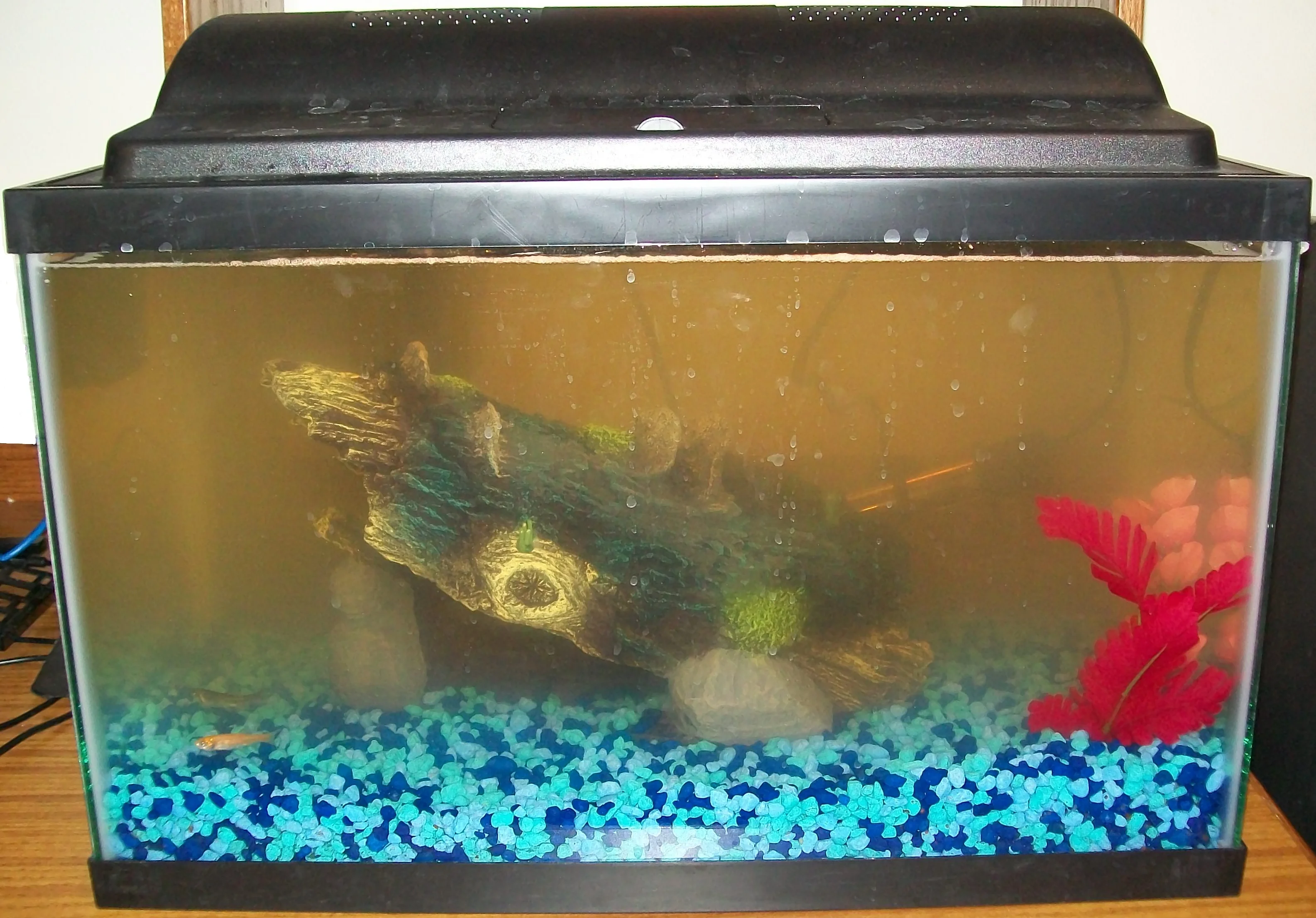In most cases, the fish tank glass will become dirty because of algae and limescale. There is no need to fret, though. In this article, you’ll read about how to clean the fish tank glass with minimal effort and equipment.

How to remove algae from the fish tank glass
One of the most common reasons for dirty tank glass is algae. We are all pretty familiar with it. To get rid of it, you can wipe it off, use a scraper, or you can purchase an aquarium magnet. Either way, your tank will look as good as new.
Simply wipe off the algae from your tank
This is an adequate solution if there is not a lot of algae buildup. However, you have to make sure that the sponge is clean. You don’t want any chemicals or detergents in your fish tank, do you? Plus, if you use this method, you don’t even have to remove all the water from the tank. Or the fish, for that matter.
At the same time, if you notice that the algae are a bit stubborn, feel free to use a sponge with an abrasive side. That way, you don’t have to scrub ‘til kingdom come. It’s worth mentioning that there are a few options on the market, even for those of you who don’t want to put your arm in the water. Scrubbers with long handles are widely available. You know…like a sponge on a stick.
Tank glass scrapers
Tougher algae require toucher tools, and that’s where scrapers come in. When you visit an aquarium store, you’ll see special tools that have a scraper on one end and a brush on the other. Kinda like the scrapers you use on your car windshield in the winter.
When using a scraper, you don’t have to remove the water from the tank. Just let the algae fall down at the bottom and clean it with an aquarium vacuum later.
I’ve also read about people using razor blades. It’s an unorthodox solution, but the blade is much thinner than the plastic scraper, and your chances of getting everything off the glass are much higher. All you have to do is hold the blade at a 45-degree angle against the glass. And be careful not to cut yourself.
Aquarium magnets
Do you know those magnetic sponges that people use to clean windows? There are such devices for aquariums as well. If you go to your local aquarium store or online, you’ll surely find some.
There are two components to an aquarium magnet. The one with the scrubbing pad goes inside the tank, and the one with the handle goes on the outside. You have to use the latter to move the sponge along the glass.
When using an aquarium magnet, make sure not to leave the magnet inside the tank. However, you’ll find some products that come with a floater, which makes them safe to leave in the tank.
One word of caution, though. You should avoid bringing the magnet too close to the bottom of the tank. When cleaning, some abrasive materials, such as sand, can get stuck under the pad. That will lead to a lot of scratches on your tank glass.
Lastly, keep in mind that aquarium magnets come in all shapes and sizes. Also, the magnets are of different strengths, so remember to purchase one adequate for your needs.
Algae eaters – a one-time effort
While removing the algae from your fish tank glass is easy with the sponge, the scraper, or the aquarium magnets, I can give you one better: algae eaters. Whether you opt for plants or living species, your tank will basically clean itself.
There are a few species of fish, snails, and crustaceans that will help you with the algae by eating it. However, before you purchase one, make sure that it will live in the tank. It all depends on which type of water you have in your aquarium – freshwater or saltwater. You also have to research the species. Some may be too big for your aquarium, while others can show aggression towards your other fish.
Here are some species that can help you remove algae from your fish tank:
- Nerite snails
- Flag fish
- Ramshorn snails
- Rosy barbs
- Bristlenose pleco
- Otocinclus
- Amano shrimp
- Twig catfish
- Siamese algae eaters
In case you don’t want to introduce other species in your fish tank, you can always opt for plats. This is a more preventive measure because they take up the light and nutrients that algae consume. With limited resources, algae buildup is not likely to happen.
At the same time, putting in some plants can beautify the tank and give your fishes places to hide. So there’s more than one benefit.
When choosing plants, make sure that the temperature and the overall environment are suitable for them. Not all plants require the same thriving conditions.
Automatic fish tank cleaners – are they worth it?
Depending on which type of tank you have, algae eaters may be a bit overwhelmed. With an automatic cleaner, all you have to do is position it and let it do its job.
There are several options on the market, and mind you that these are a bit pricey. A decent cleaner starts at about $200. However, they do come with rechargeable batteries and replaceable scrubbing pads.
There is one downside as well. The automatic fish tank cleaner needs to be repositioned every time it finishes one side of the tank. But other than that, this is a fantastic option.
How to prevent algae buildup
There are three primary methods of preventing algae buildup on your fish tank glass. You can remove excess nutrients from the water, change the water, or you could purchase a self-cleaning tank.
Having excess nutrients means that there is too much phosphate and nitrogen in the water. Since there are multiple sources, you can do several things to avoid algae buildup:
- Purify the tap water – most people use tap water to replenish their fish tanks. If you’re among them, make sure to purify it with a reverse osmosis/deionizing unit. You can find plenty of options online. Remember to change the filters, though.
- Read the saltwater mix instructions carefully – you should avoid mixes that contain phosphate and nitrogen.
- Don’t overfeed your fish – excess food will ultimately feed the algae
- Make sure that the tank is adequate for how many fish you have – a crowded tank is a perfect environment for algae buildup
- Algae thrive on light – like all plants, algae thrive if the tank is in a heavily lighted area. Make sure that your tank doesn’t get more than 10-12 hours of light each day.
How to remove limescale from a fish tank
Now that you read on how to remove algae from your fish tank glass, let’s move on to the second enemy of your aquarium – limescale. There are two primary ways to clean your aquarium glass when you have limescale deposits – cleaning solutions of plain old vinegar.
Before moving on, keep in mind that while algae buildup can be cleaned with the fishes inside the tank, not the same can be said about limescale cleaning.
How to clean fish tank glass stains with cleaning sprays
If you go to a local pet store that sells fish, you’ll see that they also sell cleaning sprays specifically designed to remove limescale. You’ll also find a wide range of such products online.
I know you may be tempted to use sprays that are designed for home use, but I must urge you not to do so. They contain chemicals that are toxic to your fish. Even if you rinse after use, traces of house cleaning spray can remain on the glass.
Now, before you use the cleaning spray, remove the fish and store them safely. Spray the tank glass thoroughly, leave it for a few minutes, and then give it a good scrub. The limescale stains should come off easily. For stubborn stains, you can use a razor or an algae scraper.
How to clean aquarium glass with vinegar
A lot of fish owners don’t like to use chemicals inside the tank, which I find perfectly understandable. That’s why they opt for a more natural method of cleaning. White vinegar is inexpensive and natural, and in no way can it hurt your fish. Plus, it is highly effective even for the most stubborn limescale stains.
To clean your aquarium glass with vinegar, you must remove your fish and drain the tank. Place the aquarium on a towel, and shower it with plain white vinegar. You have to let it sit for 10 to 20 minutes. The vinegar is acidic and acts fast. Once the 10-20 minutes pass, you need to wipe the glass with a non-abrasive cloth. Give it a quick rinse, and fill in the tank. You’re pretty much done.
How to prevent limescale deposits on your aquarium
The best way to get rid of limescale is to never let it build up in the first place. Limescale is a consequence of water evaporation, so the obvious method of prevention is to check the water line every couple of days.
At the same time, keep in mind that warm temperatures and low humidity (like in the winter) lead to fast evaporation. The limescale itself is a result of your tank water becoming harder during the evaporation process. There is a higher density of minerals. So, as the water evaporates, you need to replace it. Just make sure to use distilled water. Pure water goes out, pure water must go back in.
How to clean your fish tank glass – FAQs
How to clean the aquarium glass white residue?
To clean the aquarium glass white residue (limescale), you can use special cleaning sprays or vinegar. Both of them will remove the lime deposits, although the second option is more natural.
How to clean algae from my fish tank glass?
To remove algae from your fish tank glass, you can use a sponge, a scraper, or a magnetic cleaner. All methods are effective, and they don’t require you to remove the fish during the cleaning process.
How to clean aquarium glass inside?
To clean aquarium glass inside may require you to remove the fish. It depends on what you’re cleaning. Algae don’t require you to move the fish, but limescale cleaning does.
How to remove hard water stains from my fish tank?
To remove hard water stains from your fish tank, you can use a limescale cleaner or vinegar. However, for stubborn stains, you can use a razor or algae scraper.
How to clean the fish tank without removing the water?
Cleaning the fish tank without removing the water is possible only when you clean algae buildup. Sponges, clean clothes, scrapers, and aquarium magnets can be introduced in the water while the fish are still there. Vinegar and limescale cleaners cannot.
Last Updated on April 17, 2023

Dustin Hopkins has over 12 years in the cleaning industry, working in the past for one of the top 5 cleaning companies in the US. Currently, he is the chief editor of CleaningRank.com and the proud father of a 5-year-old, Chris.
